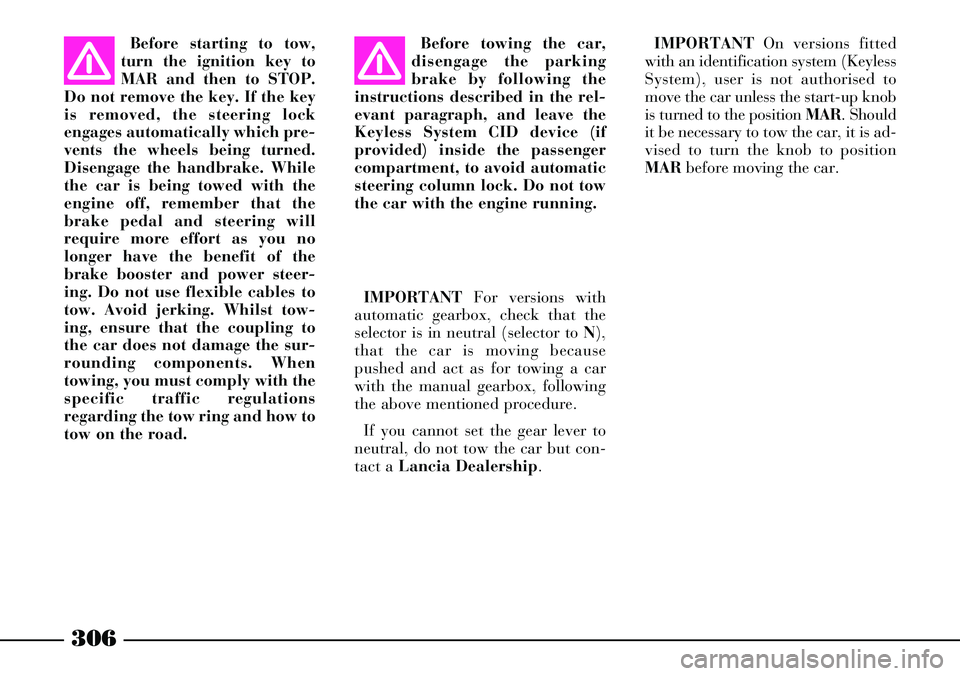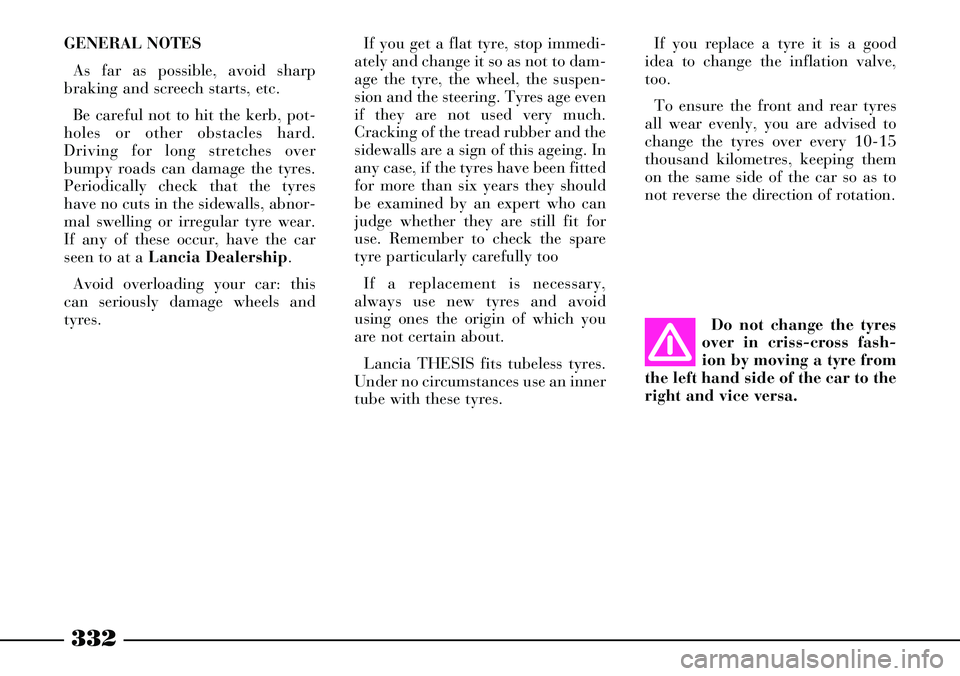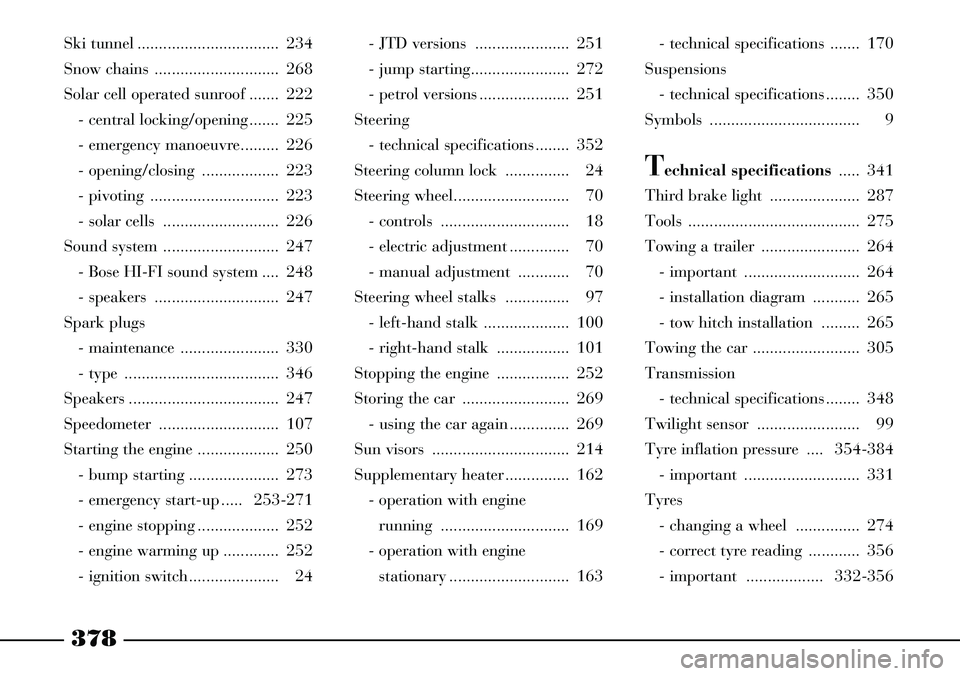stop start Lancia Thesis 2007 Owner handbook (in English)
[x] Cancel search | Manufacturer: LANCIA, Model Year: 2007, Model line: Thesis, Model: Lancia Thesis 2007Pages: 386, PDF Size: 8.69 MB
Page 307 of 386

306
Before towing the car,
disengage the parking
brake by following the
instructions described in the rel-
evant paragraph, and leave the
Keyless System CID device (if
provided) inside the passenger
compartment, to avoid automatic
steering column lock. Do not tow
the car with the engine running. Before starting to tow,
turn the ignition key to
MAR and then to STOP.
Do not remove the key. If the key
is removed, the steering lock
engages automatically which pre-
vents the wheels being turned.
Disengage the handbrake. While
the car is being towed with the
engine off, remember that the
brake pedal and steering will
require more effort as you no
longer have the benefit of the
brake booster and power steer-
ing. Do not use flexible cables to
tow. Avoid jerking. Whilst tow-
ing, ensure that the coupling to
the car does not damage the sur-
rounding components. When
towing, you must comply with the
specific traffic regulations
regarding the tow ring and how to
tow on the road.IMPORTANTFor versions with
automatic gearbox, check that the
selector is in neutral (selector to N),
that the car is moving because
pushed and act as for towing a car
with the manual gearbox, following
the above mentioned procedure.
If you cannot set the gear lever to
neutral, do not tow the car but con-
tact a Lancia Dealership.IMPORTANTOn versions fitted
with an identification system (Keyless
System), user is not authorised to
move the car unless the start-up knob
is turned to the position MAR. Should
it be necessary to tow the car, it is ad-
vised to turn the knob to position
MAR before moving the car.
Page 321 of 386

320
IMPORTANTAfter topping up, let
the engine turn for a few seconds
and wait a few minutes after stop-
ping it before you check the level.
Engine oil consumption
Max. engine oil consumption is
usually 400 grams every 1000 km.
When the car is new, the engine
needs to run in, therefore the engine
oil consumption can only be consid-
ered stabilised after the first 5000 -
6000 km. ENGINE OIL
(fig. 7-8-9-10-11-12)
Check engine oil with the car on
level ground and while the engine is
still warm (approximately five min-
utes after stopping the engine).
Remove dipstick Aand clean it,
than plunge it down and check
whether the oil level is included
between the MINand MAXrefer-
ence lines on the dipstick. The gap
between the MINand MAXrefer-
ence lines corresponds to approxi-
mately one litre of oil.Do not add oil with dif-
ferent specifications (class,
viscosity, etc.) from the oil
already in the engine.
If the oil level is near or even below
the MINline, pour in oil through the
filler hole B, until it reaches the
MAXline.
IMPORTANTIf during a routine
check you will find that the oil level
is above the MAXreference line,
contact a Lancia Dealershipto
have the proper level restored. Be very careful under the
bonnet: you risk burning
yourself. Rememberthat
when the engine is hot, the fan
can start up and cause injuries.
fig. 7 - 2.0 TB version
L0A0323b
fig. 8 - 2.4 - 2.4 CAE versions
L0A0291b
Page 333 of 386

332
If you replace a tyre it is a good
idea to change the inflation valve,
too.
To ensure the front and rear tyres
all wear evenly, you are advised to
change the tyres over every 10-15
thousand kilometres, keeping them
on the same side of the car so as to
not reverse the direction of rotation.
Do not change the tyres
over in criss-cross fash-
ion by moving a tyre from
the left hand side of the car to the
right and vice versa.GENERAL NOTES
As far as possible, avoid sharp
braking and screech starts, etc.
Be careful not to hit the kerb, pot-
holes or other obstacles hard.
Driving for long stretches over
bumpy roads can damage the tyres.
Periodically check that the tyres
have no cuts in the sidewalls, abnor-
mal swelling or irregular tyre wear.
If any of these occur, have the car
seen to at a Lancia Dealership.
Avoid overloading your car: this
can seriously damage wheels and
tyres.If you get a flat tyre, stop immedi-
ately and change it so as not to dam-
age the tyre, the wheel, the suspen-
sion and the steering. Tyres age even
if they are not used very much.
Cracking of the tread rubber and the
sidewalls are a sign of this ageing. In
any case, if the tyres have been fitted
for more than six years they should
be examined by an expert who can
judge whether they are still fit for
use. Remember to check the spare
tyre particularly carefully too
If a replacement is necessary,
always use new tyres and avoid
using ones the origin of which you
are not certain about.
Lancia THESIS fits tubeless tyres.
Under no circumstances use an inner
tube with these tyres.
Page 340 of 386

339
Engine compartment
At the end of each winter season,
carefully clean the engine compart-
ment without directing the water jet
against electronic control units.
Have this done at a garage.
Detergents pollute water.
For this reason the car
must be washed in an
area equipped for the collection
and purification of the liquids
used while washing.
IMPORTANTThe car should
washed with the engine cold and the
ignition key at STOP. After washing
make sure that the various protec-
tions (e.g. rubber caps and various
covers) have not been damaged or
removed.INTERIORS
From time to time check that water
has not collected under the mats
(from dripping shoes, umbrellas,
etc.) which could cause the steel to
rust.
Never use inflammable
products like fuel oil
ether or rectified petrol
for cleaning inside the car. The
electrostatic discharges generat-
ed when rubbing to clean may
cause fire.
Do not keep aerosol cans
in the car. There is the
risk they might explode.
Aerosol cans must never be
exposed to a temperature above
50°C; when the weather starts to
get hot the temperature inside the
car might go well beyond that fig-
ure.
PLASTIC PARTS INSIDE
THE CAR
Use special products designed not
to alter the appearance of the com-
ponents.
IMPORTANTDo not use alcohol
or petrol to clean the instrument
panel.
CLEANING ALCANTARA
SEATS
Alcantara upholstery is easy to
clean. Follow the same instructions
provided for velvet upholstery.
Page 374 of 386

373
- what triggers the alarm
off ..................................... 42
Electronic automatic gearbox
(COMFORTRONIC) ............. 180
- automatic operation ........... 182
- bump starting .................... 188
- failure indication ............... 187
- gearbox display.................. 110
- manual sequential
operation ........................... 186
- moving off ......................... 180
- selecting the automatic/
manual sequential
operation ........................... 182
- sound signal ..................... 188
- starting the engine ............ 180
- stopping ............................. 181
- technical specifications ..... 348
- towing the car ................... 189
Electronic brakeforce
distributor (EBD) .................... 245
Electronic control units
(important) ......................... 330Engine
- identification code ............ 341
- marking ............................ 341
- technical specifications ..... 344
Engine compartment
(cleaning) ............................ 339
Engine coolant ........................ 321
Engine coolant temperature
gauge .................................. 108
Engine oil
- checking level ................... 320
- specifications ..................... 364
Engine oil consumption .......... 321
Engine oil level ....................... 320
Engine warming up ................ 252
Environment
(safety and protection) ......... 4-5
EOBD system ......................... 244
EPB (electric parking brake) .. 175
- emergency disengagement.. 178
ESP system ............................ 189
- ASR function .................... 191- ESP system action ............. 192
- failure indication .............. 192
- initialising the control units
of the door locks, air
conditioner and ESP
system................................ 303
- MSR system ....................... 192
- operation .......................... 190
Exhaust gas
(recirculation system) .......... 7
External lights (controls) ........ 97
Flash consumption
gauge .................................. 109
Flashing the headlights
(main beam) ....................... 100
Fluids and lubricants .............. 364
Follow me home
(delayed light switching off) 99
Front ceiling light ................... 212
- bulb replacement .............. 287
Page 379 of 386

378
Ski tunnel ................................. 234
Snow chains ............................. 268
Solar cell operated sunroof ....... 222
- central locking/opening ....... 225
- emergency manoeuvre......... 226
- opening/closing .................. 223
- pivoting .............................. 223
- solar cells ........................... 226
Sound system ........................... 247
- Bose HI-FI sound system .... 248
- speakers ............................. 247
Spark plugs
- maintenance ....................... 330
- type .................................... 346
Speakers ................................... 247
Speedometer ............................ 107
Starting the engine ................... 250
- bump starting ..................... 273
- emergency start-up ..... 253-271
- engine stopping ................... 252
- engine warming up ............. 252
- ignition switch ..................... 24- JTD versions ...................... 251
- jump starting....................... 272
- petrol versions ..................... 251
Steering
- technical specifications ........ 352
Steering column lock ............... 24
Steering wheel........................... 70
- controls .............................. 18
- electric adjustment .............. 70
- manual adjustment ............ 70
Steering wheel stalks ............... 97
- left-hand stalk .................... 100
- right-hand stalk ................. 101
Stopping the engine ................. 252
Storing the car ......................... 269
- using the car again .............. 269
Sun visors ................................ 214
Supplementary heater ............... 162
- operation with engine
running .............................. 169
- operation with engine
stationary ............................ 163- technical specifications ....... 170
Suspensions
- technical specifications ........ 350
Symbols ................................... 9
Technical specifications..... 341
Third brake light ..................... 287
Tools ........................................ 275
Towing a trailer ....................... 264
- important ........................... 264
- installation diagram ........... 265
- tow hitch installation ......... 265
Towing the car ......................... 305
Transmission
- technical specifications ........ 348
Twilight sensor ........................ 99
Tyre inflation pressure .... 354-384
- important ........................... 331
Tyres
- changing a wheel ............... 274
- correct tyre reading ............ 356
- important .................. 332-356